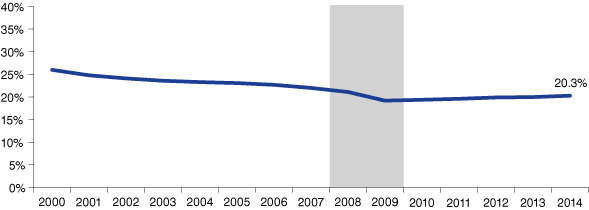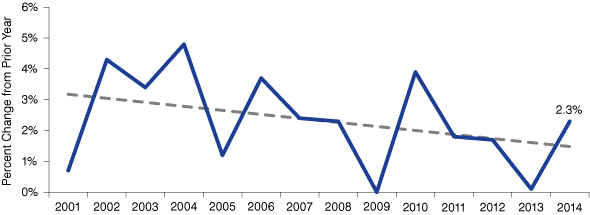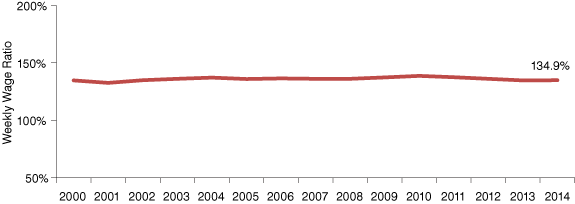Manufacturing Wage Premium Is Stable
Indiana has had a long history of reliance on manufacturing for higher wage employment. With automobile manufacturing and other heavy manufacturing either in the state or within close proximity, Indiana as a parts supply leader or distribution center has been a natural fit.
The Great Recession was a significant hit to the manufacturing industry. To better assess manufacturing in Indiana over the past 15 years, data was compiled for analysis from the Hoosiers by the Numbers website, which is operated by the Indiana Department of Workforce Development (DWD). The data are annual averages from the Quarterly Census of Employment and Wages (QCEW) series.
Indiana’s reliance on manufacturing began to decline in 2008 as indicated by its share of private employment. Indiana manufacturing employment fell from over 25 percent of employment in 2000 to below 20 percent during the Great Recession. Since the recession, however, the level has stabilized and increased slightly (see Figure 1).
Figure 1: Manufacturing Employment as a Percent of Total Private Employment

Note: Shading indicates the Great Recession.
Source: Indiana Department of Workforce Development and the U.S. Bureau of Labor Statistics (Quarterly Census of Employment and Wages)
Manufacturing has long interested policymakers and economic developers because of the wage premium usually afforded manufacturing jobs relative to other industries. However, in recent years, the growth of manufacturing wages in Indiana has been slowing (see Figure 2). The rate of growth in average weekly manufacturing wages has had a difficult time keeping up with inflation. When adjusted for inflation, real wage growth in manufacturing has been nearly nonexistent since 2000.
Figure 2: Annual Growth in Weekly Manufacturing Wages

Source: Indiana Department of Workforce Development and the U.S. Bureau of Labor Statistics
What is the cause for the slowing growth in manufacturing wages? There has been significant conjecture and research, with additional questions as a result: Is Indiana not doing enough to attract high-wage manufacturing? Is Indiana not preparing its workforce adequately to meet demand for skilled high-wage manufacturing jobs? Or, does the industry no longer see the need to pay premium wages for the more skilled employees required for advanced manufacturing jobs?
While certainly not conclusive, one method to answer these questions is to assess changes in relative weekly wages over time. Manufacturing wages have remained remarkably stable over time in terms of relative wage. Since 2000, average weekly manufacturing wages have been approximately 135 percent of the average weekly wage for total private employment (see Figure 3).
Figure 3: Ratio of Manufacturing Wages to Total Private Employment Wages

Source: Indiana Department of Workforce Development and the U.S. Bureau of Labor Statistics
The good news is that manufacturing work is still valued at a premium by employers and that this employment premium has remained relatively stable. Manufacturing jobs remain higher paying on average relative to other industries. This also suggests that an influx of lower wage manufacturing is not a rampant problem, although this does not alleviate the continued need to extend every effort to bring in higher wage manufacturing jobs. Economic development efforts must continue focusing on luring higher wage manufacturing to the state (or higher wage jobs of any sector), and everyone else (including the workforce itself) needs to focus on getting the education and training needed to adequately fill these jobs.
There is some bad news, however. The data suggests that the wage growth problem is systemic across all industries. The lack of wage growth is not a manufacturing-specific problem. The premium afforded manufacturing employees has remained stable since 2000. The problem is that wage growth in all industries has been insufficient. As all wages increase, it should follow that manufacturing wages would increase proportionally. The state must work diligently to increase the wages of all workers, however, the lack of wage growth is a national issue.
